2008 KIA Sportage fuel cap
[x] Cancel search: fuel capPage 91 of 350
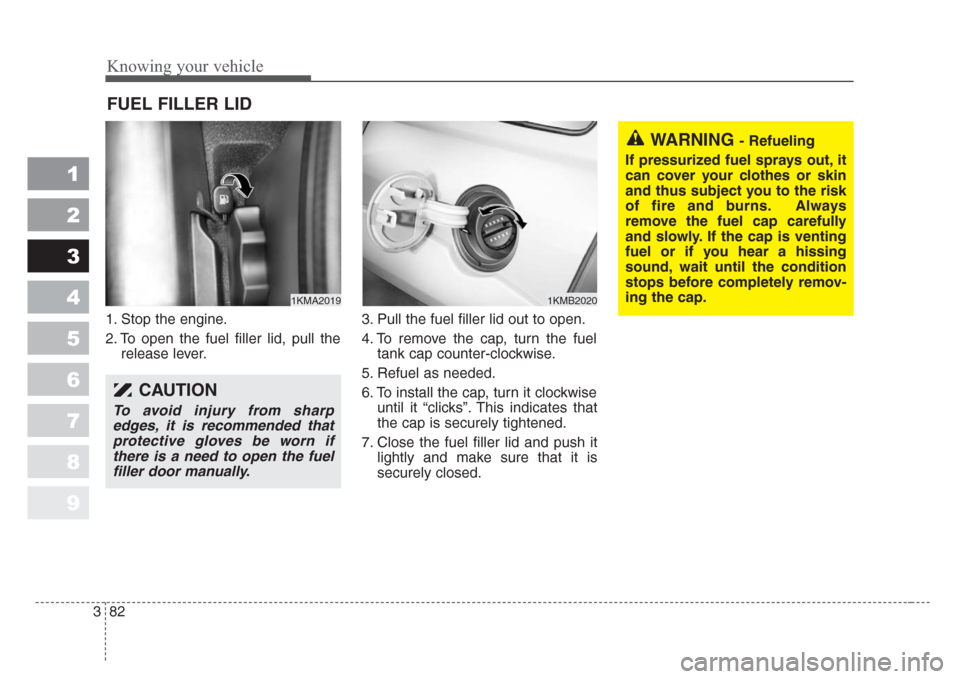
Knowing your vehicle
82 3
1
2
3
4
5
6
7
8
9
1. Stop the engine.
2. To open the fuel filler lid, pull the
release lever.3. Pull the fuel filler lid out to open.
4. To remove the cap, turn the fuel
tank cap counter-clockwise.
5. Refuel as needed.
6. To install the cap, turn it clockwise
until it “clicks”. This indicates that
the cap is securely tightened.
7. Close the fuel filler lid and push it
lightly and make sure that it is
securely closed.
FUEL FILLER LID
1KMA20191KMB2020
WARNING - Refueling
If pressurized fuel sprays out,it
can cover your clothes or skin
and thus subject you to the risk
of fire and burns.Always
remove the fuel cap carefully
and slowly.If the cap is venting
fuel or if you hear a hissing
sound, wait until the condition
stops before completely remov-
ing the cap.
CAUTION
To a v oid injury from sharp
edges,it is recommended that
protective gloves be worn if
there is a need to open the fuel
filler door manually.
Page 92 of 350
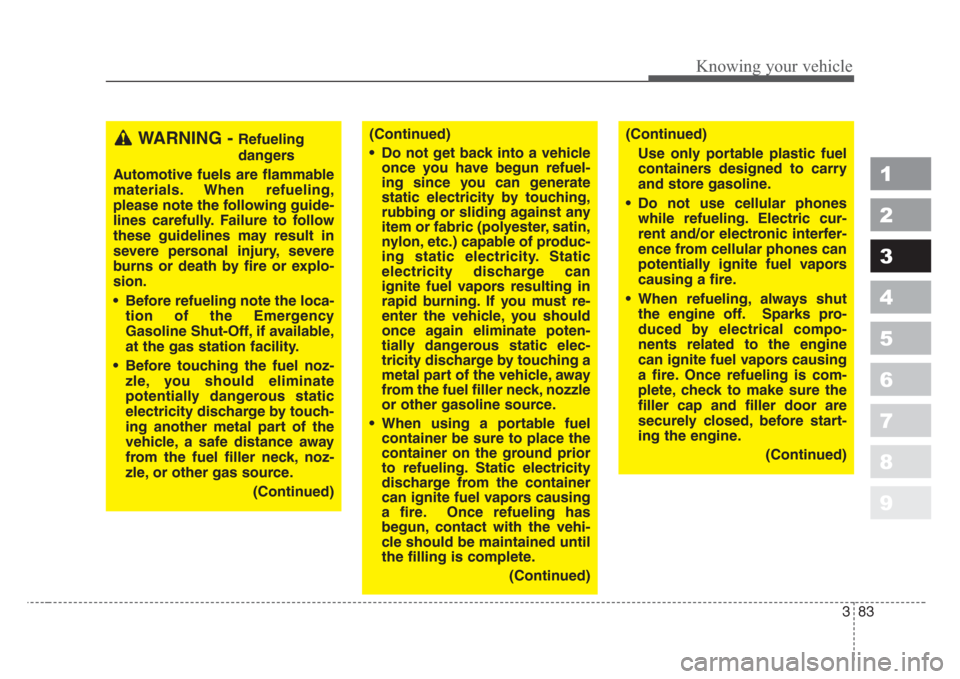
383
1
2
3
4
5
6
7
8
9
Knowing your vehicle
WARNING - Refueling
dangers
Automotive fuels are flammable
materials.When refueling,
please note the following guide-
lines carefully.Failure to follow
these guidelines may result in
severe personal injury,severe
burns or death by fire or explo-
sion.
• Before refueling note the loca-
tion of the Emergency
Gasoline Shut-Off,if available,
at the gas station facility.
• Before touching the fuel noz-
zle, you should eliminate
potentially dangerous static
electricity discharge by touch-
ing another metal part of the
vehicle, a safe distance away
from the fuel filler neck, noz-
zle, or other gas source.
(Continued)
(Continued)
• Do not get back into a vehicle
once you have begun refuel-
ing since you can generate
static electricity by touching,
rubbing or sliding against any
item or fabric (polyester,satin,
nylon, etc.) capable of produc-
ing static electricity.Static
electricity discharge can
ignite fuel vapors resulting in
rapid burning.If you must re-
enter the vehicle, you should
once again elimi
nate poten-
tially dangerous static elec-
tricity discharge by touching a
metal part of the vehicle, away
from the fuel filler neck, nozzle
or other gasoline source.
• When using a portable fuel
container be sure to place the
container on the ground prior
to refueling.Static electricity
discharge from the container
can ignite fuel vapors causing
a fire.Once refueling has
begun, contact with the vehi-
cle should be maintained until
the filling is complete.
(Continued)
(Continued)
Use only portable plastic fuel
containers designed to carry
and store gasoline.
• Do not use cellular phones
while refueling.Electric cur-
rent and/or electronic interfer-
ence from cellular phones can
potentially ignite fuel vapors
causing a fire.
• When refueling, always shut
the engine off.Sparks pro-
duced by electrical compo-
nents related to the engine
can ignite fuel vapors causing
a fire.Once refueling is com-
plete, check to make
sure the
filler cap and filler door are
securely closed, before start-
ing the engine.
(Continued)
Page 93 of 350

Knowing your vehicle
84 3
1
2
3
4
5
6
7
8
9
✽
NOTICE
• Make sure to refuel with unleaded
fuel only.
• Check to make sure the fuel filler
cap is securely closed after refuel-
ing. A loose fuel filler cap may
cause the "Check Engine"
(Malfunction Indicator) light in
the instrument panel to illuminate
unnecessarily.
• If the fuel filler cap requires
replacement, use only a genuine
Kia cap or the equivalent specified
for your vehicle. An incorrect fuel
filler cap can result in a serious
malfunction of the fuel system or
emission control system.
• Do not spill fuel on the exterior
surfaces of the vehicle. Any type of
fuel spilled on painted surfaces
may damage the paint.
(Continued)
• DO NOT use matches or a
lighter and DO NOT SMOKE or
leave a lit cigarette in your
vehicle while at a gas station
especially during refueling.
Automotive fuel is highly flam-
mable and can, when ignited,
result in fire.
• If a fire breaks out during refu-
eling, leave the vicinity of the
vehicle, and immediately con-
tact the manager of the gas
station and then contact the
local fire department.
Page 159 of 350
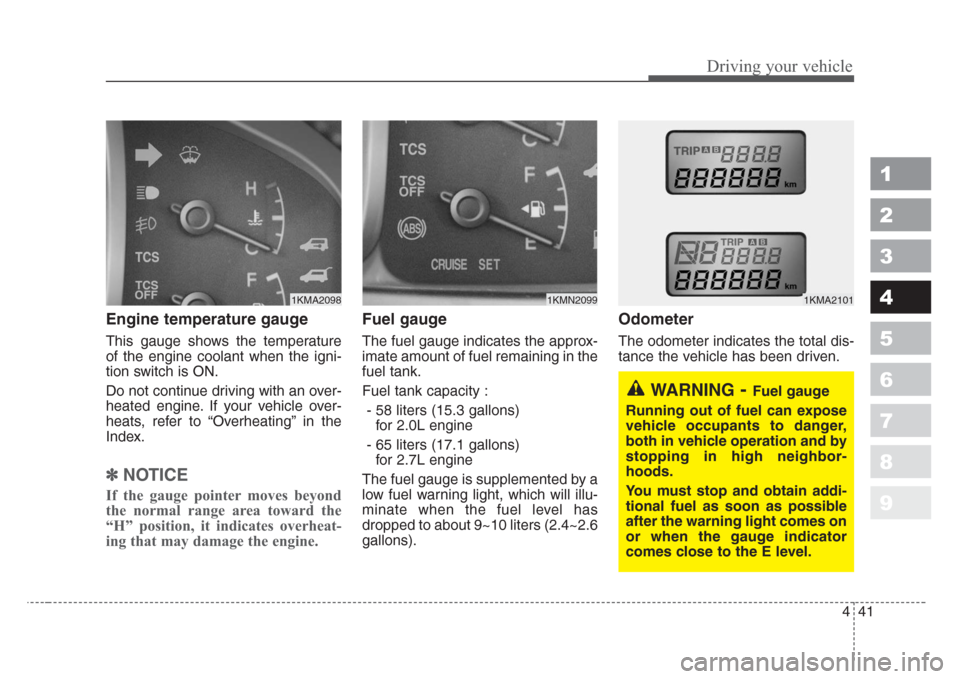
441
Driving your vehicle
1
2
3
4
5
6
7
8
9
Engine temperature gauge
This gauge shows the temperature
of the engine coolant when the igni-
tion switch is ON.
Do not continue driving with an over-
heated engine. If your vehicle over-
heats, refer to “Overheating” in the
Index.
✽
NOTICE
If the gauge pointer moves beyond
the normal range area toward the
“H” position, it indicates overheat-
ing that may damage the engine.
Fuel gauge
The fuel gauge indicates the approx-
imate amount of fuel remaining in the
fuel tank.
Fuel tank capacity :
- 58 liters (15.3 gallons)
for 2.0L engine
- 65 liters (17.1 gallons)
for 2.7L engine
The fuel gauge is supplemented by a
low fuel warning light, which will illu-
minate when the fuel level has
dropped to about 9~10 liters (2.4~2.6
gallons).
Odometer
The odometer indicates the total dis-
tance the vehicle has been driven.
1KMN20991KMA21011KMA2098
WARNING-Fuel gauge
Running out of fuel can expose
vehicle occupants to danger,
both in vehicle operation and by
stopping in high neighbor-
hoods.
You must stop and obtain addi-
tional fuel as soon as possible
after the warning light comes on
or when the gauge indicator
comes close to the E level.
Page 167 of 350
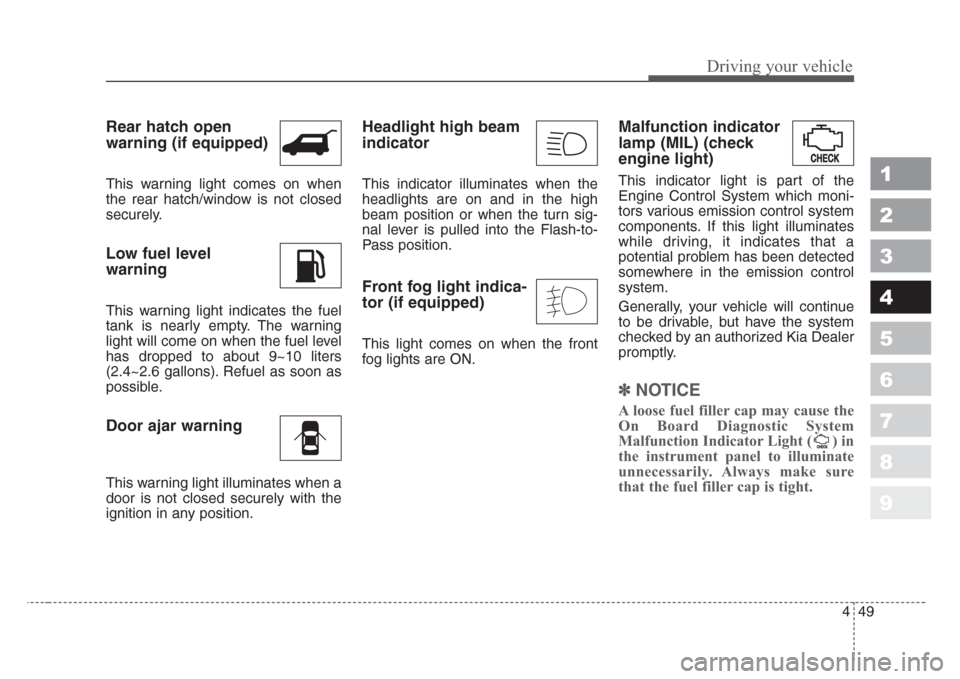
449
Driving your vehicle
1
2
3
4
5
6
7
8
9
Rear hatch open
warning (if equipped)
This warning light comes on when
the rear hatch/window is not closed
securely.
Low fuel level
warning
This warning light indicates the fuel
tank is nearly empty. The warning
light will come on when the fuel level
has dropped to about 9~10 liters
(2.4~2.6 gallons). Refuel as soon as
possible.
Door ajar warning
This warning light illuminates when a
door is not closed securely with the
ignition in any position.
Headlight high beam
indicator
This indicator illuminates when the
headlights are on and in the high
beam position or when the turn sig-
nal lever is pulled into the Flash-to-
Pass position.
Front fog light indica-
tor (if equipped)
This light comes on when the front
fog lights are ON.
Malfunction indicator
lamp (MIL) (check
engine light)
This indicator light is part of the
Engine Control System which moni-
tors various emission control system
components. If this light illuminates
while driving, it indicates that a
potential problem has been detected
somewhere in the emission control
system.
Generally, your vehicle will continue
to be drivable, but have the system
checked by an authorized Kia Dealer
promptly.
✽
NOTICE
A loose fuel filler cap may cause the
On Board Diagnostic System
Malfunction Indicator Light ( ) in
the instrument panel to illuminate
unnecessarily. Always make sure
that the fuel filler cap is tight.
Page 242 of 350
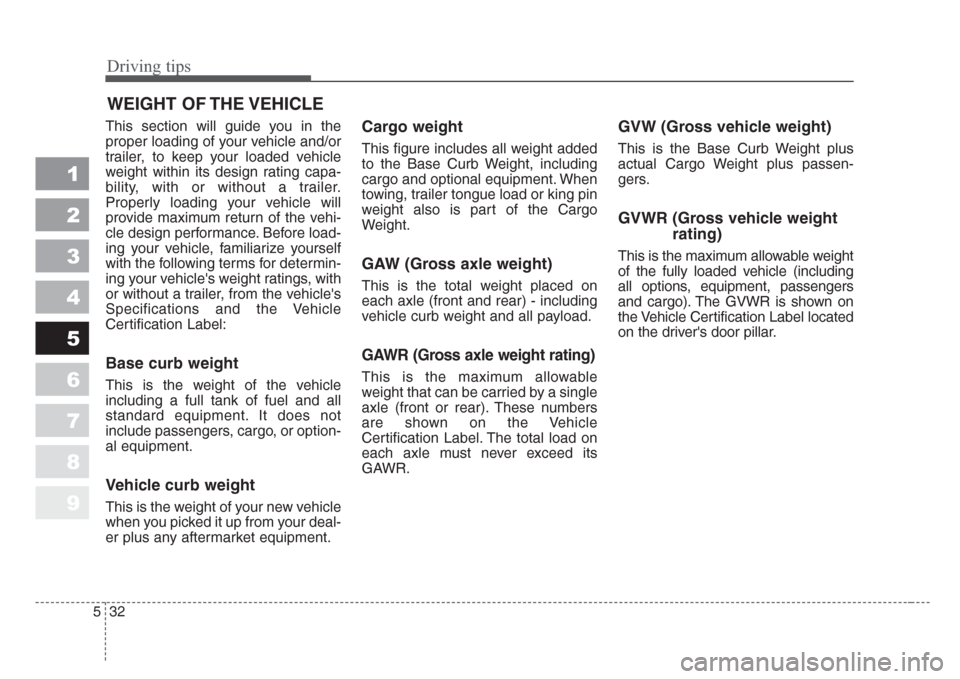
Driving tips
32 5
1
2
3
4
5
6
7
8
9
WEIGHT OF THE VEHICLE
This section will guide you in the
proper loading of your vehicle and/or
trailer, to keep your loaded vehicle
weight within its design rating capa-
bility, with or without a trailer.
Properly loading your vehicle will
provide maximum return of the vehi-
cle design performance. Before load-
ing your vehicle, familiarize yourself
with the following terms for determin-
ing your vehicle's weight ratings, with
or without a trailer, from the vehicle's
Specifications and the Vehicle
Certification Label:
Base curb weight
This is the weight of the vehicle
including a full tank of fuel and all
standard equipment. It does not
include passengers, cargo, or option-
al equipment.
Vehicle curb weight
This is the weight of your new vehicle
when you picked it up from your deal-
er plus any aftermarket equipment.
Cargo weight
This figure includes all weight added
to the Base Curb Weight, including
cargo and optional equipment. When
towing, trailer tongue load or king pin
weight also is part of the Cargo
Weight.
GAW (Gross axle weight)
This is the total weight placed on
each axle (front and rear) - including
vehicle curb weight and all payload.
GAWR (Gross axle weight rating)
This is the maximum allowable
weight that can be carried by a single
axle (front or rear). These numbers
are shown on the Vehicle
Certification Label. The total load on
each axle must never exceed its
GAWR.
GVW (Gross vehicle weight)
This is the Base Curb Weight plus
actual Cargo Weight plus passen-
gers.
GVWR (Gross vehicle weight
rating)
This is the maximum allowable weight
of the fully loaded vehicle (including
all options, equipment, passengers
and cargo). The GVWR is shown on
the Vehicle Certification Label located
on the driver's door pillar.
Page 243 of 350
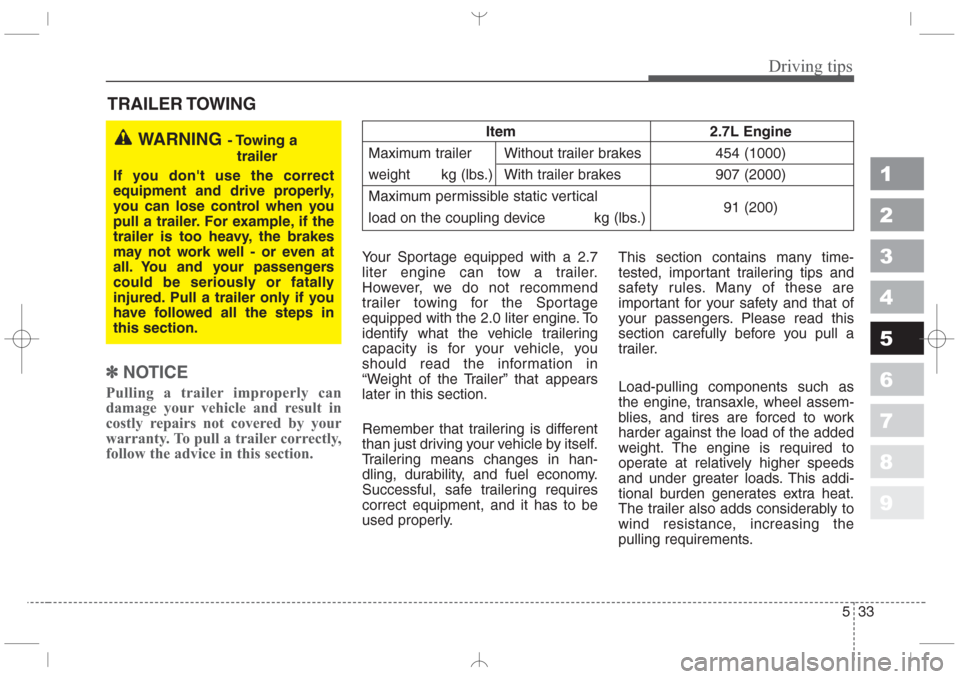
533
Driving tips
1
2
3
4
5
6
7
8
9
TRAILER TOWING
✽
NOTICE
Pulling a trailer improperly can
damage your vehicle and result in
costly repairs not covered by your
warranty. To pull a trailer correctly,
follow the advice in this section.
Your Sportage equipped with a 2.7
liter engine can tow a trailer.
However, we do not recommend
trailer towing for the Sportage
equipped with the 2.0 liter engine. To
identify what the vehicle trailering
capacity is for your vehicle, you
should read the information in
“Weight of the Trailer” that appears
later in this section.
Remember that trailering is different
than just driving your vehicle by itself.
Trailering means changes in han-
dling, durability, and fuel economy.
Successful, safe trailering requires
correct equipment, and it has to be
used properly.This section contains many time-
tested, important trailering tips and
safety rules. Many of these are
important for your safety and that of
your passengers. Please read this
section carefully before you pull a
trailer.
Load-pulling components such as
the engine, transaxle, wheel assem-
blies, and tires are forced to work
harder against the load of the added
weight. The engine is required to
operate at relatively higher speeds
and under greater loads. This addi-
tional burden generates extra heat.
The trailer also adds considerably to
wind resistance, increasing the
pulling requirements.
WARNING- Towing a
trailer
If you don't use the correct
equipment and drive properly,
you can lose control when you
pull a trailer.For example,if the
trailer is too heavy, the brakes
may not work well - or even at
all.You and your passengers
could be seriously or fatally
injured.Pull a trailer only if you
have followed all the steps in
this section.Item 2.7L Engine
Maximum trailer Without trailer brakes 454 (1000)
weight kg (lbs.) With trailer brakes 907 (2000)
Maximum permissible static vertical
load on the coupling device kg (lbs.)91 (200)
Page 253 of 350
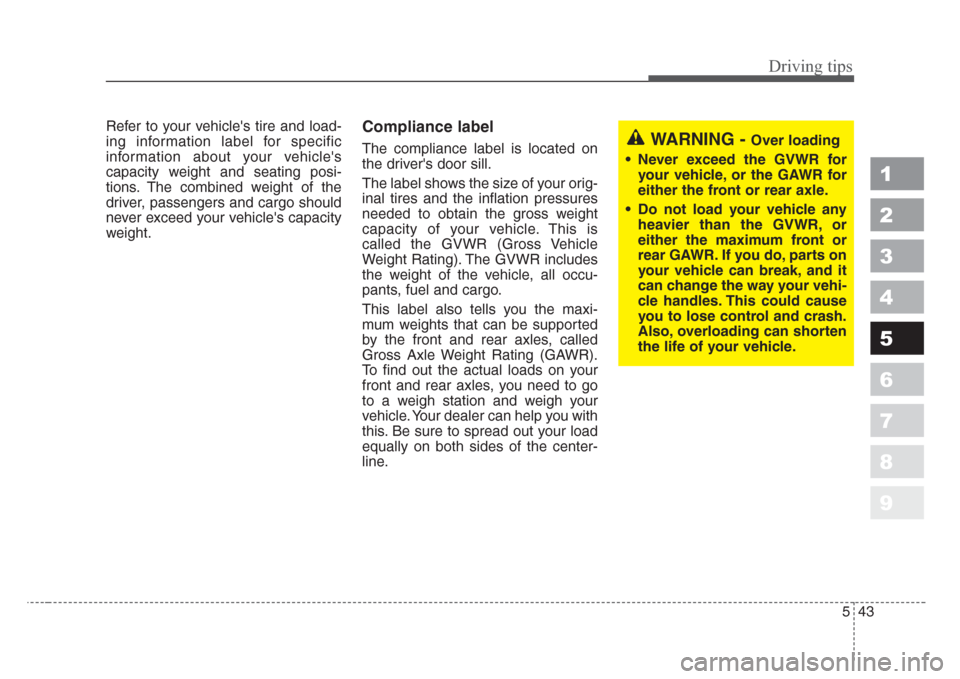
543
Driving tips
1
2
3
4
5
6
7
8
9
Refer to your vehicle's tire and load-
ing information label for specific
information about your vehicle's
capacity weight and seating posi-
tions. The combined weight of the
driver, passengers and cargo should
never exceed your vehicle's capacity
weight.Compliance label
The compliance label is located on
the driver's door sill.
The label shows the size of your orig-
inal tires and the inflation pressures
needed to obtain the gross weight
capacity of your vehicle. This is
called the GVWR (Gross Vehicle
Weight Rating). The GVWR includes
the weight of the vehicle, all occu-
pants, fuel and cargo.
This label also tells you the maxi-
mum weights that can be supported
by the front and rear axles, called
Gross Axle Weight Rating (GAWR).
To find out the actual loads on your
front and rear axles, you need to go
to a weigh station and weigh your
vehicle. Your dealer can help you with
this. Be sure to spread out your load
equally on both sides of the center-
line.WARNING - Over loading
• Never exceed the GVWR for
your vehicle, or the GAWR for
either the front or rear axle.
• Do not load your vehicle any
heavier than the GVWR, or
either the maximum front or
rear GAWR.If you do, parts on
your vehicle can break, and it
can change the way your vehi-
cle handles.This could cause
you to lose control and crash.
Also, overloading can shorten
the life of your vehicle.